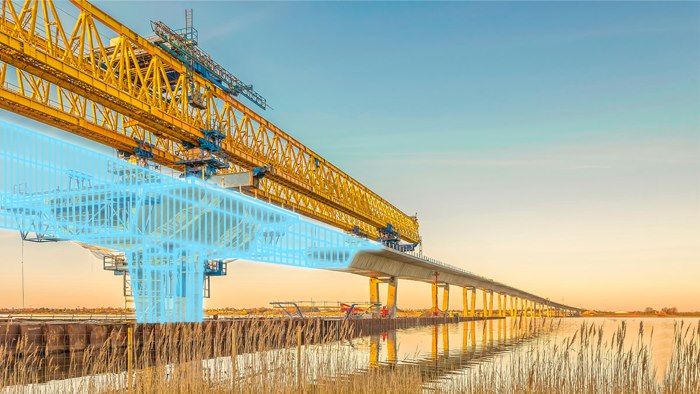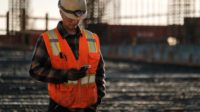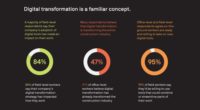
Over the past two years, the construction industry has done whatever it takes to deliver projects despite huge challenges. The uncertainties faced by engineering and construction will worsen as governments begin to boost their post-COVID-19 spending on infrastructure and inflationary pressures bite deeper. We are at a turning point where organizations can choose to embrace the technology revolution that is underway in construction and, by doing so, win more projects with profitable margins, deliver them more efficiently and more safely, develop sustainable competitive advantage and survive long enough to reap the benefits.
The Landscape
Construction productivity has advanced at a glacial pace over the past 30 years and margins remain stubbornly low. According to the CBI’s Fine Margin report, in 2019 the UK’s 10 largest contractors by revenue made an average profit margin of -0.1% compared with an average 2.6% across the top 100 firms. That was an improvement on the previous year’s paltry -0.9% but contractors see very little financial gain, especially considering they hold most of the risk affecting project outcomes.
Margins that hover around 0%, even in more prosperous times, are a constant threat to businesses. When projects go wrong then old habits kick in, claims multiply, investment in technology and training stops, and firms can go bust. For contractors, risk and margin are two sides of the same coin. Risk allocation and management are two of the biggest barriers preventing construction companies from making the sustainable margins that would encourage and promote investment in business improvement.
In a competitive tender process, it is challenging to prepare accurate pricing for materials, labor, and time, even before trying to assess the likely time and cost impacts of different project risks. Poorly informed estimates mean that contractors’ bids can be overly high or low, and contracts can leave almost no room to correct things once work has started. That is important because the Get It Right Initiative found that direct costs of avoidable errors in the field are around 5% of the project value. Factor in unrecorded process waste (6%), indirect costs (7%), and latent defects (3%), then up to 21% of project costs are wasted. Let that number sink in. Overall, the annual cost due to error is estimated to be around seven times the total annual profit of UK construction industry, and the UK is not unique.
In a review of 1,400 projects globally, the 2021 CRUX Insight report found that the value of claims amounted to almost half of the budgeted capital expenditure, on average, and extensions of time claimed typically lengthen a construction program’s schedule by more than 70%. In Australia, an investigation by the Grattan Institute found that almost half of public road and rail projects with an initial cost of more than AUD 1 billion had cost overruns averaging more than 30%.
Digital solutions and processes can help to kick-start big improvements in project performance, and other industries have shown that companies that are quick to embrace emerging technologies will gain a strong competitive advantage.
Many of the challenges faced by construction companies in recent years were around long before COVID-19, but the pandemic made them harder to cope with. For example, within organizations it can be hard to manage and use the vast amount of data that is available. It is difficult to scale best practices across an organization, and it is hard to attract and retain the best people and use them to best effect on projects. Externally, there are challenges that amplify internal problems such as complex projects, interconnected teams, fragmented value chains, and extensive subcontracting. None of these make projects easier, but the pandemic has accelerated the adoption of new technology and is beginning to change how construction companies operate.
The Opportunity
Technology can play an important part in changing how the industry designs and constructs projects, and how it reskills the workforce. Construction is complicated, and change can be hard. Consider, for example, the activities needed to deliver a new railway project: it may involve multiple organizations, in different countries, using different software, at different stages, to plan, analyze, design, construct, and manage the asset. The construction team on site must take all this data and information and use it to deliver the railway on time and within a budget usually set by a competitive tender process. With an average margin of 2.6% across the top 100 UK firms, and direct costs of avoidable errors in the field of around 5% of project value, its vital to start with an accurate, robust estimate. Every dollar makes a difference.
Gone are the days when digitalization simply meant transitioning steadily from 2D to 3D to 4D. It encompasses data analytics, lifecycle simulation, modular design, BIM, VDC, 3D scanning, reality modeling, site optimization, off-site fabrication, 3D printing, robotics, site automation, operational analytics, or asset performance management. You probably shouldn’t be trying all of these at once, but you should be considering which ones you will do and why, when you will start and how you will deliver them.
Constructioneering is a term used to describe how various technologies fit together to support practical workflows. It is important to understand at the outset that the best outcomes are often experienced by organizations that implement technologies and workflows tailored closely to business and project requirements. For example, many construction companies cite “cost reduction” as a driver for digitalizing their operations, but the appropriate solution will depend on whether cost overruns are caused by, for example, poor design (use better BIM tools), subcontractors using out-of-date drawings (use a connected data environment), or inefficient site practices (equip people with mobile devices to access and contribute data in the field).
Constructioneering Driven by Five Industry Trends
First, next-generation BIM: Many projects are still working in a BIM Level 1 environment, without using a collaboration process. Next-generation BIM uses the latest BIM software combined with a best-practice connected data environment.
Collaboration and mobility: Cloud-based connected data environments transform projects by enabling real-time collaboration, and it encompasses a connected data environment as a crucial component. It means that users can access trusted data from anywhere, securely, at any time, and on any device.
Near-perfect data capture: High-resolution images and 3D models can be produced in near real-time using GPS, photogrammetry, and LiDAR. Drones and handheld scanners are improving the accuracy and quality of surveys, and reducing the time needed to capture the source data.
The Internet of Things: IoT sensors can track real-time data from equipment, crews, and materials. Cloud computing enables that data to be analyzed and exploited in near real-time, which improves decision-making, cost control, risk management, and site safety.
Autonomous navigation and autonomous machines: The products of this fifth trend are appearing more frequently on site. However, if you are using a new robotic digging machine, then you need to ensure it is digging the right hole in the right place at the right time, based on the right drawing or model.
Constructioneering provides organisations with the modular technology, tools, and processes to digitalize their operations and a robust framework for the infrastructure digital twin.
Digitalizing, One Step at a Time
With all that technology to choose from, it can be difficult to know where to start. Successful projects ensure they get the basics right, and spend time and effort implementing best practices. There is currently a lot of interest and activity around digital twins but they are not something you can simply buy and turn on when needed. They offer huge potential to improve project delivery, but they build on existing best practices. Organizations that get the basics right will have a robust foundation for implementing the infrastructure digital twin.
It starts with creating high quality components — for both vertical and linear assets. The industry has access to the latest design and BIM technology, which can help to ensure that designs are complete, consistent, and correct. The ability to view design content created using 3D design software in immersive environments such as NVIDIA’s Omniverse is a next step. Such integrations allow engineering-grade, highly accurate content to be visualized with photorealistic lighting and environmental effects on web browsers, workstations, and mobile devices.
Next, best-practice workflows ensure your data is managed securely and effectively. A connected data environment, or CDE, supports a robust BIM process. A CDE is a simple principle: it stores and manages content created by the team, and it delivers that to the right people, in the right format, at the right time, for the task. Why should you care about collaboration and information management? KPMG reported that information management could secure up to $7.53 of direct labor productivity gains for every $1.25, and up to more than $8.78 in direct cost savings from reductions in time and materials.
The third consideration is context. Surveying technology means that it is easy to place and review components in their correct context. Reality modeling is routinely used to monitor construction works on site. By flying a drone-mounted camera along, say, the route of a new highway at regular intervals, the precise CAD/BIM reality models can be used to accurately measure progress.
Next, projects commonly have data in different formats from different sources, so it is important to consider the alignment, accountability, and accessibility of data. Data alignment ensures that you can take design information from different software applications and reuse it. Data accountability means that you know who created the information, and what it can be used for. Data accessibility ensures that your construction teams can get the information they need by using their preferred device — wherever they are. At Bentley, we have developed an open-source way of doing this called Bentley iTwins to store, manage, and use different types of data in a cloud database.
On a project, content creators work in their preferred authoring tools. Project participants can then access the trusted data they need, when they need it, in the right format for the task. Importantly, the construction teams work with the data using simple apps and browsers. Engineers on site can use their mobile phone to view models, raise RFIs, and create issues. They can also run the 4D construction sequence. Anything they do on their phone can be synchronized with the team’s other project data with modern cloud databases.
Working in this way helps to ensure data integrity, so that contractors can avoid rework, resolve disputes, and create accurate as-built information.
However, many construction companies still rely on emails and spreadsheets and other time consuming, error-prone processes. Projects persevere with spreadsheets even when studies have shown that nearly 90% contain errors. Construction teams need to start using integrated networks of mobile apps and processes to streamline data transfer.
When you have the components, the workflows, and the context then you have the basis for a construction digital twin.
Create-Connect-Consume
One of the simplest definitions of a digital twin is “a digital representation of a physical asset, process or system.” However, a digital twin is a live, evolving set of data that must be continuously synchronized and it should exploit data-driven workflows to optimize performance. Infrastructure digital twins are being enabled by advances in areas such as reality modeling, artificial intelligence, mixed reality, and machine learning. More of this technology is becoming available every day and it is getting a lot cheaper.
There can be multiple versions of a digital twin throughout the lifecycle of an infrastructure asset, enabling users at all stages to make better-informed decisions for better outcomes. The construction digital twin is founded on inputs such as design data (2D, 3D, BIM, GIS, and so on), preconstruction information (record information, health and safety hazards, planning information, and so on), and feeds from the field (IoT data, progress updates, drone data, inspection data, for example). The inputs support construction workflows such as 4D planning, model-based estimating, and machine automation. The result is a jump in productivity.
Three Steps to Construction Digital Twins
Gather the design and reality models and transform them quickly and efficiently into constructible content: Data from multiple sources is stored in the cloud and made available through apps and web browsers for tasks such as 4D scheduling and simulation, and model-based estimating. 4D is one of the easiest and most effective ways to implement digital best practices because it does smart things with existing design and schedule data. Proponents commonly report 10-15% shorter construction schedules when compared with company and industry benchmarks although for many contractors completing projects on time would represent success. By making designs constructible and identifying and correcting mistakes in the model rather than on site, step 1 is where construction teams set themselves up for success.
The construction model is connected to real-time updates from the field to create the live model: this helps teams to better orchestrate site logistics, work areas, resources, and procurement.
An example is using a solution such as EarthCam 4D, that fully synchronizes time-sequenced images from site to 4D planning models, providing immediate, real-time evidence of every component’s installation against the 4D model.
Leverage the live model using analytical tools, machine learning, and augmented reality: Workflows wherein site teams submit live progress updates from the field using mobile apps. Progress data is used to update the master 4D model so that planners, schedulers, and project managers can make timely, informed decisions about optimizing the path of construction. Smart 4D planning software can quickly run multiple scenarios to bring a project back on track after an unexpected delay or alter procurement to optimize cashflow. Issues can be identified early, and it helps to keep the project in control by enabling faster decisions based on better data. Without data, you are just another person with an opinion.
A construction digital twin can help your projects by providing real-time data visibility so that everyone is always on the same page at the same time. It provides 4D planning and 5D estimating so that resources are optimized, and risks are reduced, and it provides operational efficiencies and business intelligence so that teams make better decisions faster.
Trending in the Right Direction
It is crucial for the construction industry to start exploiting digital technology to do a lot more with a lot less. Construction is starting to shift in the right direction. We are moving from the old ways of doing things to new ways. Construction software is enabling project teams to define and implement best practice processes — and to do that consistently across every project. Digitalization means that everyone can be on the same page at the same time and make better decisions faster. It means that resources can be optimized, risks are mitigated, and rework is avoided. It also means that teams spend more time working on value-added tasks. Ultimately, construction technology is helping firms to win projects, deliver them more efficiently, and improve their profitability.
Paul King is solution director, construction, with Bentley Systems. He can be reached at paul.king@bentley.com.



